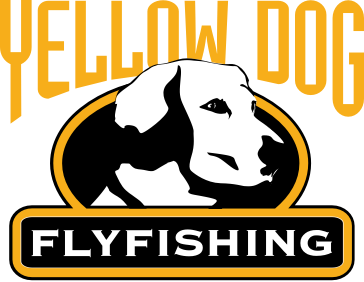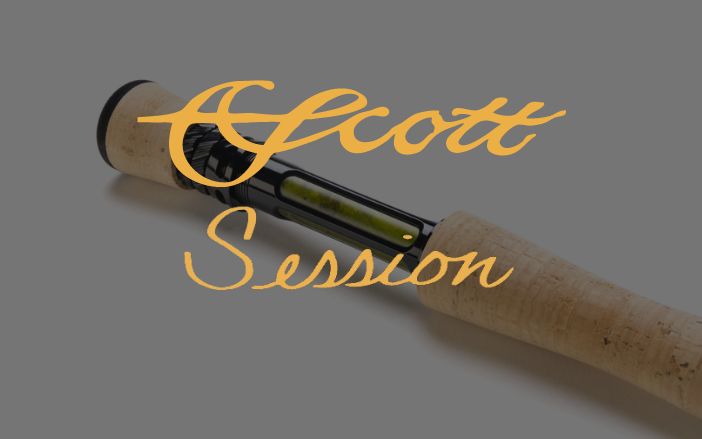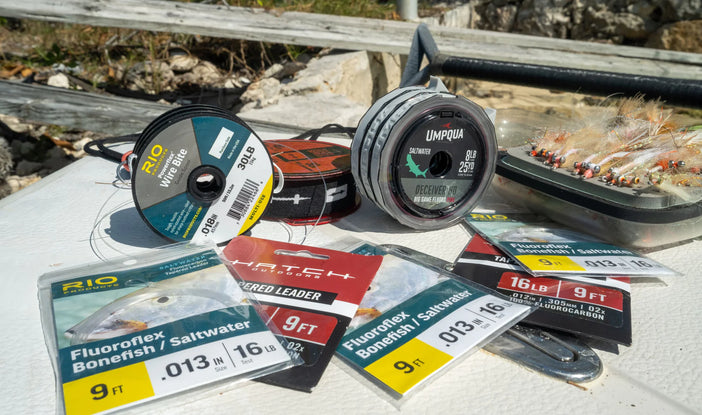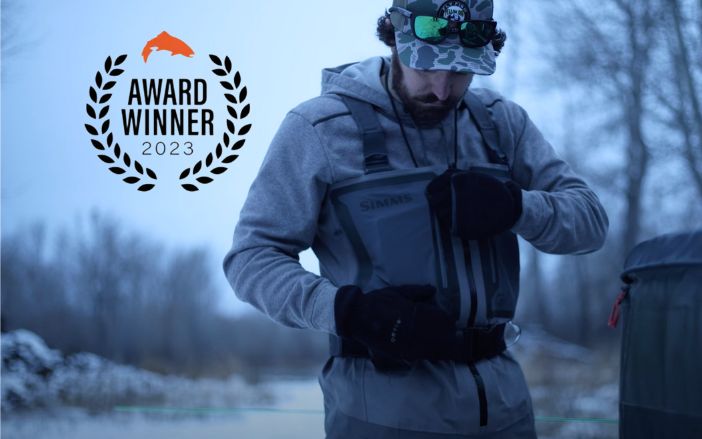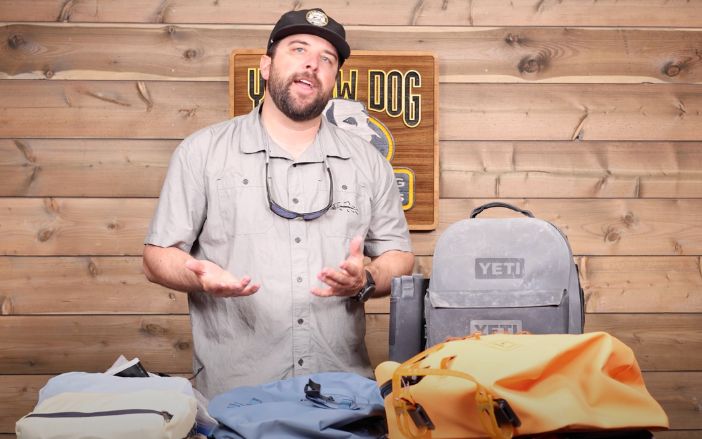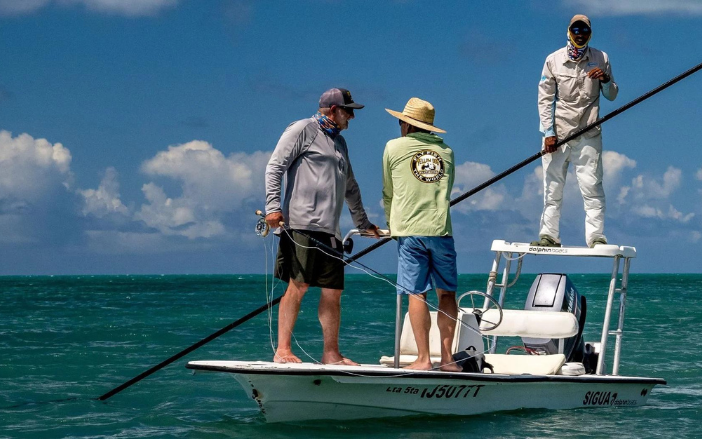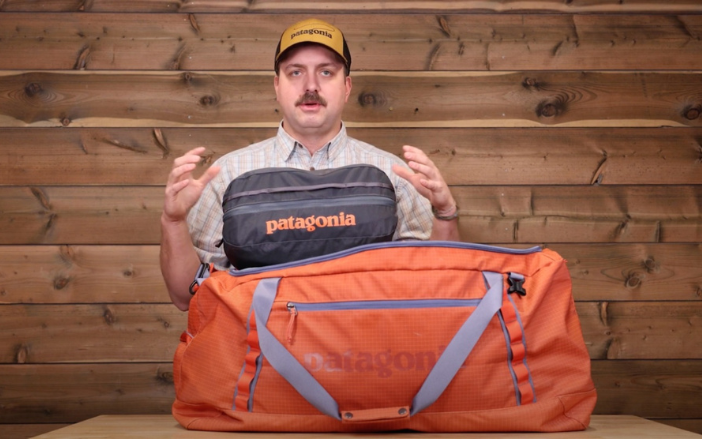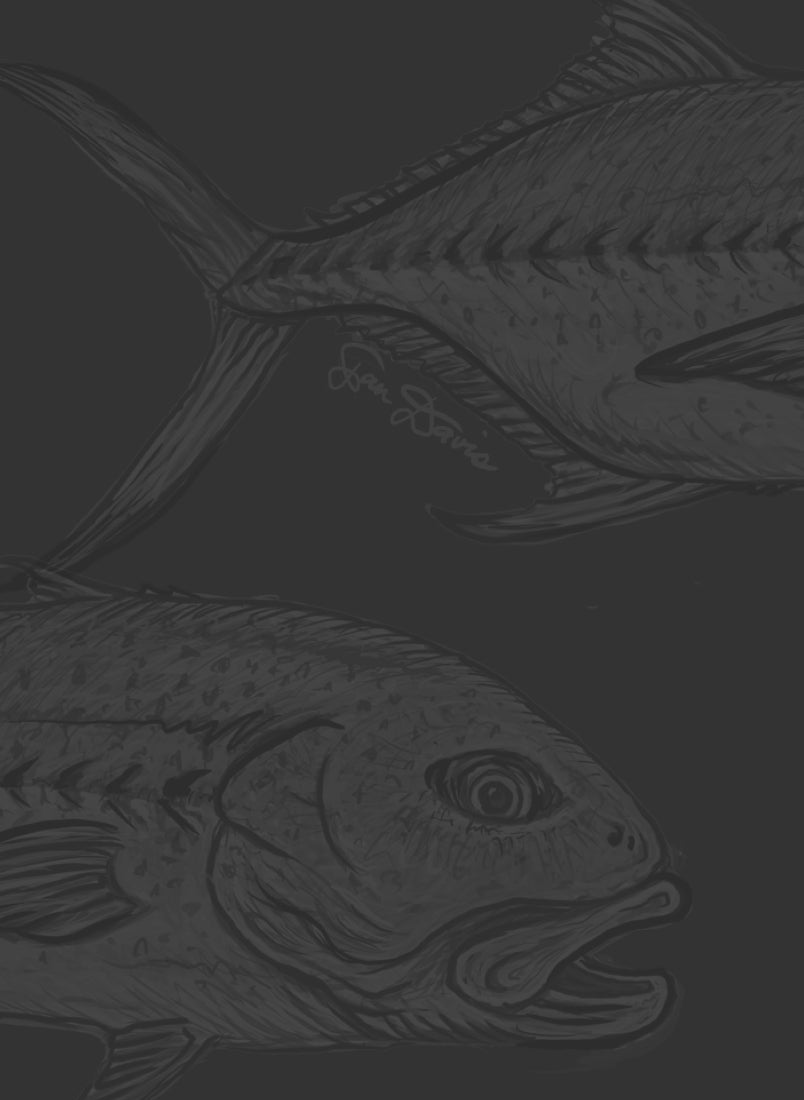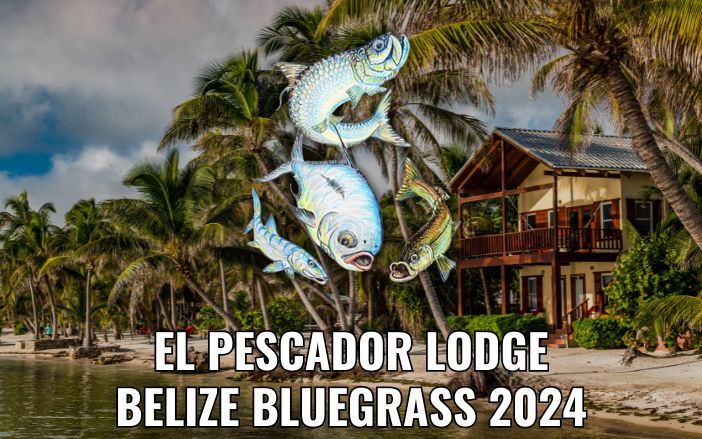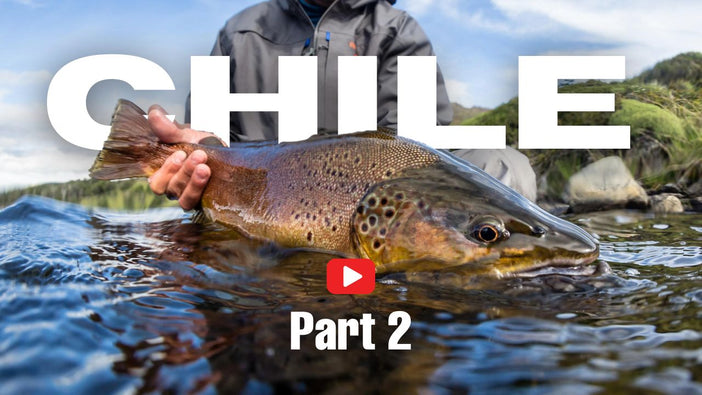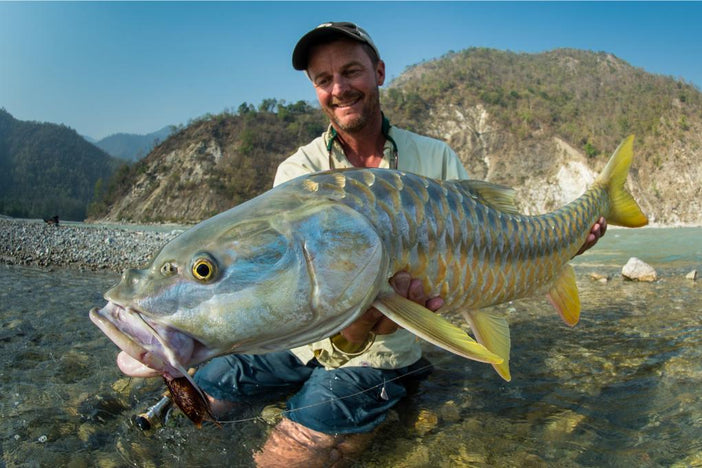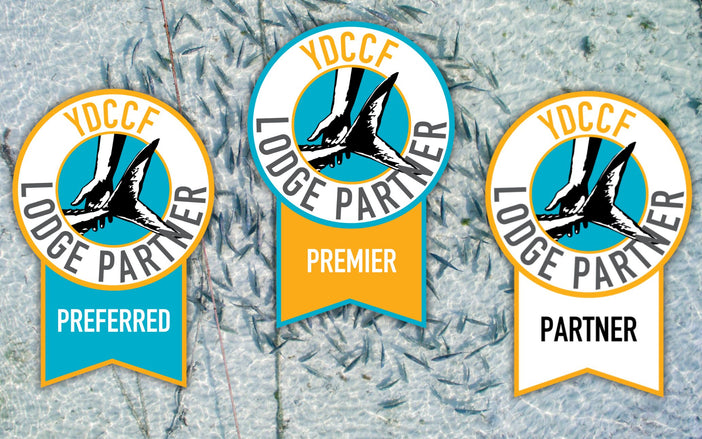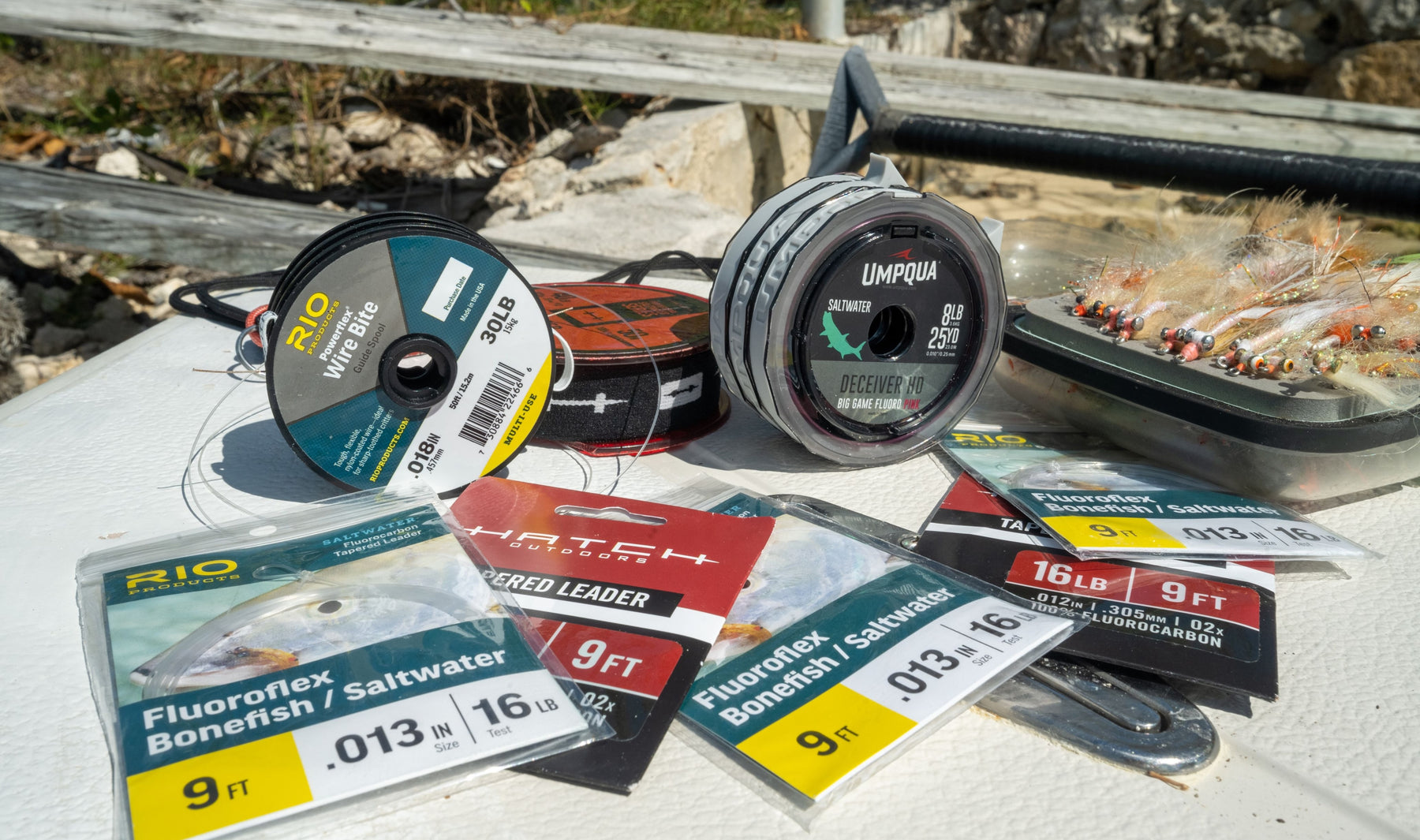The world of leaders and tippet for saltwater fly fishing can be confusing and sometimes messy. There are no absolutes when it comes to saltwater leaders, as many anglers and guides have very specific preferences in leader strength, length, material, and more based on the target species and location. Weather conditions, casting ability, the size and weight of the fly, water clarity, and more all impact what is the "best" leader setup, but there are some general best practices.
The Parts of a Leader
A quick and very important note for those just starting to dip their toes into fly fishing: there are three general parts of a saltwater leader: Butt, Class, and Shock/Bite tippet.

1. BUTT SECTION The butt section of a tapered leader is what attaches to your fly line, and is always the heaviest (weight class) part of the leader. By having a heavier butt section, the transfer of energy between your fly line and leader will be more efficient and will assist in turning over the fly. In an ideal world, the end of your fly line and beginning of your butt section should be close in diameter as possible for optimal energy transfer.
2. CLASS TIPPET The class section of a tapered leader is the weakest point, and what denotes the weight class (EX: A store-bought 12# tapered bonefish leader will start heavier and slowly taper down to 12#). The class section is the last or second to last portion of your leader, depending on if you are using a piece of shock tippet.
3. SHOCK TIPPET (Not for all Species): Finally, shock tippet is a short section of leader material added to the end of the leader for the purpose of added strength and abrasion resistance. Shock tippet is not always needed, but is a must for species such as tarpon, barracuda, or sharks. A tarpon's gill plate or a barracuda's teeth will make quick work of a 20# leader, so a section of heavier nylon, fluorocarbon, or wire (depending on the species) offers that necessary added protection.
Fluorocarbon Versus Nylon
This is a whole other topic in itself, but at bare minimum, understanding the pros and cons of each material is a must when discussing saltwater fly fishing leaders.
- Strength: Fluorocarbon is more abrasion resistant and stiffer than nylon, making it preferable if you're fishing around structures such as coral, mangroves, or pylons that could potentially snag and cut your leader.
-
Visibility: Fluorocarbon "disappears" when wet while nylon can potentially refract light and spook fish. Fluorocarbon is by no means invisible when wet, but can offer a touch more of stealth when targeting spooky fish in clear conditions. Pink fluorocarbon has become popular in the saltwater fishing community, as it is one of the first wavelengths of light to disappear under water.
- Sink Rate: Fluorocarbon also sinks faster than nylon. If you need to get your fly down quickly (think fishing crab flies for permit or triggerfish), opt for fluorocarbon.
On the flip side, if you want to better control your flies sink-rate and location in the water column (think tarpon or cruising redfish), nylon is a better option.
These differences are often marginal, but important on a case-by-case basis.
- Knots: Knots are easier to tie and seat with nylon because it is a softer, more supple material. This is an especially important detail when dealing with heavier leader material for big game species. If the knot isn't tried and true, the leader strength DOES NOT MATTER. Your leader is only as good as the knots creating it. With that in mind, store-bought tapered leaders reduce the number of required knots, and the most likely fail-point is at the fly.
There aren't "wrong" choices here, but nuances to each material that make one or the other the better option. Keep in mind, fluorocarbon costs more and is less environmentally friendly as it virtually never breaks down.

Leaders and Tippet for Saltwater Gamefish
Before we dive into some species-specific leader systems, there are a few fundamentals to know and keep in mind.
- The longer your leader, the harder it will be to cast. If your guide recommends you fish a 14' leader but you are unable to cast it well and efficiently present the fly, adjust. Cutting a couple feet off of a long leader can make a big difference when casting is a challenge.
- The larger, heavier, or more wind-resistant the fly, the heavier and/or shorter your leader system needs to be to ensure the fly can turn over. A heavier butt-section is key in this scenario.
- Casting in heavy winds is problematic for most anglers--Shortening and/or strengthening your leader's test makes for easier casting in windy conditions.
- If conditions are flat calm, you must nearly always lengthen/size down your leader for added stealth.
- The combination of your rod, fly line, and leader system does make a difference. The action of your rod combined with your casting stroke, the taper of your line, and the accompanying leader are all at play in the final product of your fly presentation. Don't be afraid to experiment to find what works best for you! Elite guides and anglers learn from one another, but also develop their own systems and innovate when needed.
Making adjustments are on-water decisions that come with experience and working with your guide.
With all of that in mind, lets look at some species-specific leader recommendations.
Bonefish
Bonefish are often the first saltwater species anglers target on fly given they are readily accessible and found in greater abundance than say permit or tarpon. Bonefish leaders are fairly straight forward, but you do find some variation based on location as your average Seychelles bonefish is much larger than those encountered in The Yucatan.
- Standard Leader: 9 or 10' 12# leader
- Recommended Tippet: 10, 12, & 16#
Larger fish are far more common in The Bahamas and bonefish pushing double digits are landed throughout the year! It is common to size up in The Bahamas as opposed to sizing down, especially when fishing deeper water with heavier flies which is common for trophy bonefish.
- Standard Leader: 9 or 10' 16# leader
- Recommended Tippet: 12, 16, & 20#
- Standard Leader: 9 or 10' 16# leader
- Recommended Tippet: 16 & 20#
+ View the Bonefish Equipment List

Permit
There are a 101 reasons why that permit didn't eat -- the fly, the moon phase, the cast, the sink rate, their unpredictable behavior... Don't let your leader be a factor. There is a delicate balance with permit leaders, as you want to have the longest and smallest diameter leader you can effectively cast without jeopardizing losing the fish. This can be as short as nine feet, with some experienced anglers and casters fishing fourteen foot leaders (or more).
Permit guru Wil Flack and owner of Belize Permit Club has plenty of experience targeting permit throughout the Caribbean and says this:
"I like fluorocarbon for abrasion resistance. Ten to twelve foot leader tapered leader, whether you build your own or buy the tapered leaders off the shelf -- 12, 16, and 20#. My go-to every day is probably a 10' 16# leader for Belize."
His note about fluorocarbon is important: while knots seat a touch easier with nylon, fluorocarbon offers greater abrasion resistance--a vital asset when fishing around structure that can easily break you off such as a coral head or a mangrove.
Flack goes on to say his approach absolutely changes based on conditions."It depends on weather conditions--10' 16# on average days, but if there is no wind at all, 10 or 12#. If its blowing 25 knots and you've got a good angler, your fishing 20#."
+ Waypoints Podcast: Wil Flack: Feeding Permit - Tips & Techniques for the Black-Tailed Devil
- Standard Leader: 10 - 12' 16# leader
- Recommended Tippets: 10, 12,16, & 20#
- Standard Leader: 10 - 12' 12# Leader
- Recommended Tippet: 12, 16, & 20#
+ View the Permit Equipment List

Giant Trevally
There are no tapers when it comes to giant trevally leaders; a straight, heavy piece of leader material is required to stand up to their brute strength. Former guide on Alphonse and Seychelles Program Director Alec Gerbec has this to say on GT leaders:
"As a whole, a GT leader is a uniform diameter. There is no taper needed — The guides want to keep the integrity of the diameter, and they don’t want knots to weaken the system. Its going to be pretty heavy, and there is no class tippet because of how the fish fight."
Until recently, nylon monofilament was the primary leader material, but this is slowly changing. Alec states, "For the longest time the guides used nylon: it seats knots well, is strong, and performed consistently over the years, but now fluorocarbon is entering the market in the sizes that they fish.
The fluorocarbon acts as an intermediate tip and will sink your fly faster, but its difficult to seat a knot perfectly. Fluoro can help get the fly down in wash, but can be too much when fishing shallow flats."
Depending on the scenario, both fluorocarbon and nylon have an advantage--but the weight and length doesn't really change.
- Standard Leader: 8 or 9' 100-130#
- Recommended Tippet: 80, 100, 130, and in rare instances, 150#
+ View the Giant Trevally Equipment List

Redfish
Your redfish leader is going to vary based on where you are fishing. In Louisiana, the fish are not considered leader shy, and much larger on average. And while the flats and marshes around Texas, the Carolina's, and Florida hold plenty of reds, the fish are generally smaller and more wary, requiring a longer and lighter leader setup.
- Standard Leader: 6 - 8' 20-40#
- Recommended Tippets: 20, 30, & 40#
- Standard Leader: 10' 12 or 16#
- Recommended Tippets: 12, 16, and 20#
+ View the Redfish Equipment List

Tarpon
Many of the world's best tarpon guides have their own personal leader systems they have developed over many years on the water. These handmade leaders frequently follow a formulaic approach, with specific lengths and diameters to each section, often combining both fluoro and monofilament, and employing different types of knots.
With that in mind, your leader setup will vary greatly depending on if you are targeting juvenile tarpon or adult tarpon. In destinations such as the North Yucatan, perhaps the best juvenile tarpon fishery on earth, it is common to fish a straight or tapered 16-20# leader. Depending on conditions and fish behavior, a guide may want to size up or down.
If you are fishing for adult tarpon in The Carribean or jungle destinations such as Costa Rica, your leader setup will depend a lot on your guide's preferences. In some locations, guides will recommend fishing a straight piece of heavy leader material. This approach will work, but is inherently risky for both your own and the fish's safety. In the event a shark appears on the flat, you have zero ability to break the fish off to avoid predation.
Additionally, if the line becomes wrapped around your finger, ankle, or wrist while tight on a tarpon, there is no chance that leader breaks with a straight section of 40+ pound leader material. By fishing a standard class section of roughly 16# with a sufficient shock tippet, both fish and fisherman can avoid unnecessary risk. If you want to fish by the book, IGFA-legal leaders are designed to allow you to ethically and responsibly fight a tarpon, and break it off should you need to.
A fairly straight forward recipe to build your own tarpon leader would be as follows:
- 4 - 5 feet of 60# (Butt - Nylon monofilament)
- 2.5 - 3 feet of 40#
- 2.5 - 3 feet of 16# (Class - Nylon monofilament)
- 1 - 1.5 feet of 60# (Shock/Bite - Fluorocarbon)
To learn more about making your own tarpon leaders, watch the video below from Florida Keys guide Bruce Chard:
As a sidenote, you can buy ready-to-go tapered tarpon leaders in a variety of sizes, and for beginners, this is easily the best solution!

Triggerfish
Triggerfish are one of the most difficult species to hook and land on fly due to their behavior, shell-crushing jaws, and an uncanny ability to break anglers off via a coral head.
For triggers, you are always fishing relatively small crab or shrimp flies (#4 - 8) that are lightly weighted for a subtle presentation. For bonefish, this would mean a 9' 12# leader would be more than enough to turn over the fly, but triggerfish are a different animal. Similar to permit, a longer leader in the 10 to 12' range is recommended to give yourself some added cover. Additionally, triggerfish naturally search for protection once hooked and will often take up shelter in coral beds. For this reason, opt for a heavier fluorocarbon leader!
- Standard Leader: 10-12' 20#
- Recommended Tippets: 20 & 25#

Barracuda / Sharks
If you plan on landing a barracuda or shark on fly, you better bring some wire! While its technically feasible to hook them in the corner of the mouth and avoiding their razor-sharp teeth, you should not count on finding much success.
You can start with something as simple as 6 to 8 feet of straight 20-30#, with the addition of 1 to 1.5 feet of 30-40# wire bite tippet. If you want a tapered leader, follow the same general format as a Louisiana redfish leader with a few feet of 40-50# leader material down to a few feet of 20-30#.
Given that barracuda and shark flies tend to be on the larger side, you can always opt for a shorter leader system to aid with casting.
- Standard Leader: 6 - 8' 30# with 1.5' 40# wire bite tippet
- Recommended Tippets: 20, 30, & 40# & 30 or 40# wire tippet
Having confidence in a leader, rod, or fly can absolutely impact your catch rate. If you are worrying about the knot you tied, your fly selection, or your leader when targeting a fish, you are no long focusing on the task at hand. Remember, adapt to changing conditions, and experiment on finding what system works best for you.
Related Articles:
- Bonefish Leader & Tippet Advice from Jeff Currier and Oliver White
- Fly Fishing for Roosterfish: Tactics, Flies, & Gear
- Cuba Fly Fishing Gear Guide: Everything You Need
- Yucatan Fly Fishing Gear Guide: Everything You Need
- Bahamas Fly Fishing Gear Guide: Everything You Need
- Seychelles Fly Fishing Gear Guide: Everything You Need
